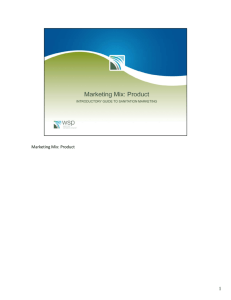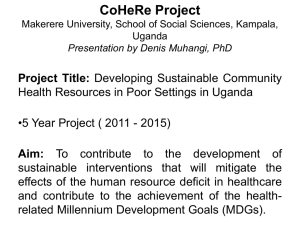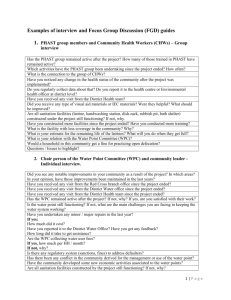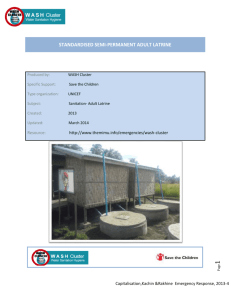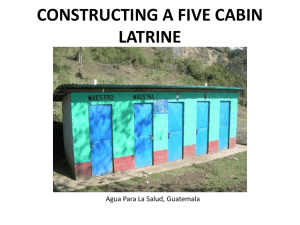standardised semi-permanent child latrine
advertisement
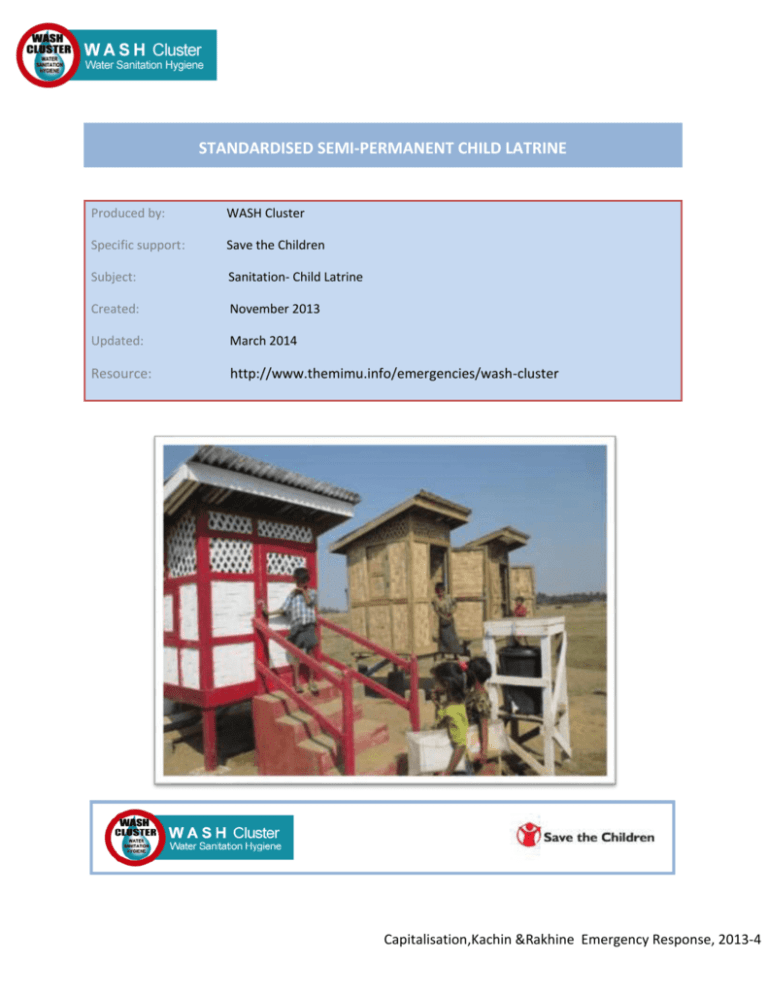
STANDARDISED SEMI-PERMANENT CHILD LATRINE Produced by: WASH Cluster Specific support : Save the Children Subject: Sanitation- Child Latrine Created: November 2013 Updated: March 2014 Resource: http://www.themimu.info/emergencies/wash-cluster Capitalisation,Kachin &Rakhine Emergency Response, 2013-4 Background The purpose of this document is to formalize a standardized cluster design of child latrine semipermanent latrines which has been considered as one of the important cross cutting issues1 to be properly addressed, in a protective perspective. In addition Children are also identify as one of the main sources of open defecation in camps, leading to the needs to develop more attractive latrines for that target population. As any other standard from the Wash cluster it constitutes a work document for all actors, including donors, defining the minimum standard to be applied. This proposed designed is considered applicable for Camp environment in both Rakhine and Kachine emergency. This particular design of child latrine was originally developed by Save the Children International after consulting with children and using participatory approach in the whole process of the construction of the latrine. The design is already used by the WASH agencies in Rakhine Emergency Response, following technicalexchange in working group.This document is subjected to change based on the regular review and inputs from the field situation. Particulars of the Design The primary intended users are the children aged from 4~8 years as the children of this age group primarily develop the habits and behavior that can affect the life-long health. The major changes were adapted according to the consultation with the children from temporary learning and child friendly spaces2. No. 1. 2. 3. Findings from consultation Adaptation in designs with children Size of the latrine is too big The height of the latrine is for the children reduced to the maximum height of 8 year old child from the community. Location of the locker is too The location of the locker from height for the children the inside is changed to the appropriate height of the children. Children complaint of the Water sealed ceramic latrine bad smell from the latrine pan was used to prevent the pan smell. Remark This in turn prevents the adults using the latrines as the height of the latrine is greatly reduced. As a consequence, the slope of the latrine pipe becomes higher and the Superstructure of the latrine was raised to keep theinlet of the latrine pipe at normal place. Extra-beams were used to align the floor with the 1 Priorities Identified WASH CLUSTER STRATEGIC OPERATIONAL FRAMEWORK RAKHINE AND KACHIN STATES IDP CRISIS RESPONSE 2 Temporary learning space (TLS) and Child-friendly space (CFS) in the camp compounds Capitalisation,Kachin &Rakhine Emergency Response, 2013-4 4. 5. 6 7. 8. squatting plate. The amount of water use is increased due to the water sealed ceramic pan. Steps with the sand bag is Concrete steps with handrail The cost of the latrine becomes very slippery for children were replaced instead of sand higher. bags. Children are scared of the Bamboo meshes were placed Privacy of the users is darkness inside the latrine. instead of bamboo wall to let maintained. the light in. Chidlren sometimes need Window at the side was inserted help and even trapped with the locker outside to inside the latrine. ensure that there is an access available by the caretaker as wellas in the case of emergency. Majority of the children Children voted the colour Colour of the exterior of the dislike the black colour of through the pocket chart and latrine should be changed latrine. majority of children like the red accroding to the preference of colour. Thus, red colour was the children. used to paint the Superstructure. The remaining parts of the latrine including the accessories item for cleaning and the pit were the similar to the recommended design of the latrine in general. Perspective of the design Figure 1 Child Latrine (Plan View) Capitalisation,Kachin &Rakhine Emergency Response, 2013-4 Figure 2 Child Latrine (Side View) Figure 3 Child Latrine with concrete ring (Side View) Capitalisation,Kachin &Rakhine Emergency Response, 2013-4 Figure 4 Child Latrine (Isometric Views) Guidance notes: All child latrines should meet the recommended standards from Sanitation Minimum Sphere Standard Package3.The desludging and decommission of all the child latrines should meet the recommended procedures and solutions. At least 1 child latrine in temporary learning space and child-friendly space. Latrine should be as close as possible from TLS or CFS (recommended distance is 50m), while staying at 30m from water point. Latrine maintenance: o For each 10 latrines there is one person responsible for the maintenance (hourly cleaning, water and soap for hand washing point). In the emergency phase, this person will be paid 3000/day, working every day. During the early recovery phase, other option involving community participation will have to be chosen. These workers should be rotated frequently (every week or every month). o A standard latrine maintenance kit will be distributed for each block of latrine: Disabled-friendly latrine Should include the following: o Include a seat (chair frame with a hole in the middle) o include a bar on the wall near the near, to help children sitting o make the latrine door larger, for people with crouches, and make sure door open towards the outside o make the access step larger horizontally, for easy use with crutches 3 Sanitation Minimum Sphere Standard Package 2012/3 by WASH Cluster, www.themimuinfo/emergencies/washcluster Capitalisation,Kachin &Rakhine Emergency Response, 2013-4 Cost and BOQ of Child Latrine The following prices per items are purely indicative, depending on the market fluctuation and also the scope of order. However the total cost defined below is considered by the cluster as the average price to achieve qualitatively the minimum standard targeted. The minimum calculated cost of 1 child latrine is around 340 USD. The labour charges are not included in this calculation. The Bills of Quantity for the Child Latrine developed by the Save the Children International are as follow: Sr. 1 2 3 4 5 6 7 8 9 10 11 12 13 14 15 16 17 18 19 20 21 22 23 24 Particular ( Timber ) 3" x 3" x 58 ft ( Timber ) 4" x 2" x 24 ft (Timber) 3" x 2" x 100 ft (Timber) 3" x 1.5" x 30 ft (Timber) 3" x 1" x 90 ft Wooden (6"x0.75"x 80 ft) Floor Concrete Footing with MS flab Concrete Ladder Nail 3" Nail 1" Nail 1.5" Nail 2" Nail ( for zin sheet ) 7' x 3' ( corrugated zinc sheet ) Ceremic Pan & Pipe (water trap) Concrete ring (ø 5' x 1.5') Concrete ring lid (ø 5' x 3'') PVC Pipe ø 4" PVC Elbow ø 4" , (angle - 45') PVC Pipe ø 3" PVC elbow ø 3'' Hinge, Handle, etc: Paint (red and white) Bamboo Sub-total Contingency 5% Total Approximated Amount Unit Ton Ton Ton Ton Ton Ton nos nos viss viss viss viss viss sheet pair nos nos ft nos ft nos pair nos nos Quantity 0.0725 0.0267 0.0833 0.0188 0.0375 0.0333 4 1 0.25 0.25 0.25 0.25 0.25 3 1 5 2 7 1 7 1 1 2 60 Rate 300000 250000 250000 250000 250000 250000 5000 20000 2500 2500 2500 2500 2500 2500 25000 19000 9000 900 1500 500 500 3000 7500 250 Amount 21750 6675 20833 4700 9375 8333 20000 20000 625 625 625 625 625 7500 25000 95000 18000 6300 1500 3500 500 3000 15000 15000 305092 15254.6 320346.6 320000 Remark Superstructure Superstructure Superstructure Superstructure Superstructure Superstructure Superstructure Superstructure Superstructure Superstructure Superstructure Superstructure Superstructure Superstructure Latrine Pit Latrine Pit Latrine Pit Superstructure Superstructure Superstructure Superstructure Superstructure Superstructure Superstructure ~340 USD (1USD= 950 MMK) Main Findings & Lesson Learned (after being applied for 4 months) The participatory approach with children has been applied before the design was developed. The findings from the consultation with children were incorporated in the finalization of the design. It was found that the design of the adult latrines significantly differed from the children’s imagination. The cost per one latrine becomes higher than the typical latrine design after adapting the design. These child latrines were mainly constructed at the temporary learning and child-friendly spaces due to the availability of the land is limited at the camp or community level. Thus, it can still affect the behaviour of the child at household level. Capitalisation,Kachin &Rakhine Emergency Response, 2013-4 Recommendations 1. Participatory approach should be continued wherever possible. 2. Effort should be placed in continuing the regular monitoring of the latrine usage in children. 3. Child Latrine should be constructed at the camp level to ensure that the children have the enabling environment both at the household and institutional levels. 4. Colour of the Superstructuresuperstructure may need to be changed as the different children group may have different preferences in colour. 5. The window at the side of the latrine needs to be locked and the key should be kept at the safe hands. 6. Desludging and Decommissioning of the child latrines should follow the common procedures for the adult latrines. Capitalisation,Kachin &Rakhine Emergency Response, 2013-4

